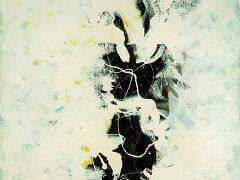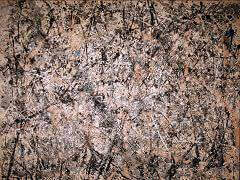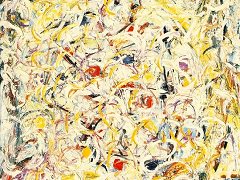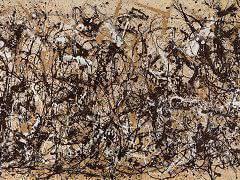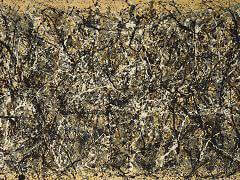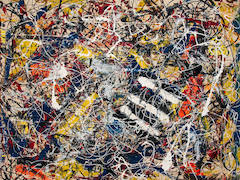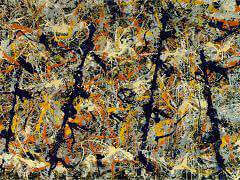Composition (White, Black, Blue and Red on White), 1948 by Jackson Pollock

Composition (White, Black, Blue and Red on White), 1948, part of the permanent collection at the New Orleans Museum of Art, is an excellent example of Pollock's style of gesture (action) painting. Composition typifies Pollock's 'drips,' or flung paint, which he painted in a rhythmic, undulating style. By the time Pollock completed Composition, he had moved the canvas from the easel onto the floor, enabling him to interact equally with the canvas's four sides. A few years earlier he had abandoned the paintbrush in favor of applying paint with non-conventional tools including sticks and spatulas. The placement of the thickly layered paint derived from the movement of Pollock's body through space records his performance. The eye may follow and trace an individual strand of paint, and through its unpredictable twists and turns, recreate his dance. Thus, the painting vibrates with his presence and resonates with his movement over and across the canvas.
Completed in the late 1940s, Composition reflects work Pollock painted when he was sober. Several critics consider the images painted during this period his best. An early example of his 'drips,' Composition retains an experimental quality as the technique was still new to Pollock. Pollock innovated a new style not only with the direct application of paint, but also as observed by Irving Sandler in The Triumph of American Painting, because his paintings did not outline planes or define images. Devoid of any figures, Composition represents the pure abstraction Pollock had achieved by the mid-1940s. Here, the painting creates an all-over image in which there is no focal point, making all parts of equal importance. No one color is prioritized; blue, black and white paint is evenly distributed, the red paint more subtle only in that the other colors overlap it. The absence of a focal point also forces the eye's movement around the painting, refusing its attempts to settle on one particular location. Additionally, the eye perceives the image as a whole, not in segments.



